 |
|
|
|
 |
|
|
|
There is more to Corregidor than being the site of the defeat and surrender of America’s forces in the Philippines, and the devastating battle to retake it three years later. It symbolizes war’s duality - destruction and creativity, brutality and comradeship, inhumanity and humanity, yes. But before all of this, before World War II, it was an idyllic place for the Army families who lived there. This is the pictorial story of that other
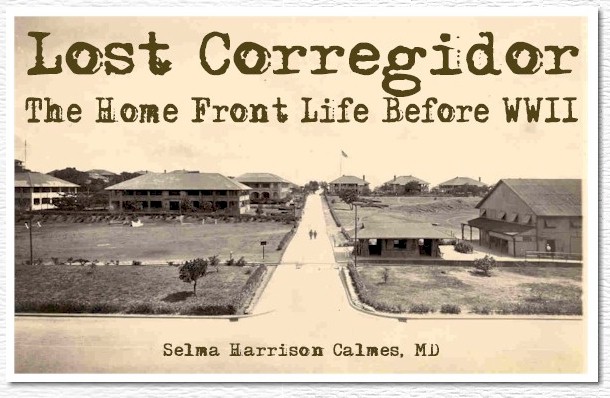
part 1
 Corregidor
entered our family’s life in 1923, when my grandfather, Captain Robert
M. Carswell, was first stationed there, commanding B Battery of
the 59th Coast Artillery. He had been a civil engineer and
lawyer in his home town of Wilmington, Delaware. He also served in the
Delaware National Guard, and was called up for duty in the Mexican
Punitive Expedition against bandit Pancho Villa. Apparently the Army
offered more opportunity than civilian life, and he joined the regular
Army soon after.
Corregidor
entered our family’s life in 1923, when my grandfather, Captain Robert
M. Carswell, was first stationed there, commanding B Battery of
the 59th Coast Artillery. He had been a civil engineer and
lawyer in his home town of Wilmington, Delaware. He also served in the
Delaware National Guard, and was called up for duty in the Mexican
Punitive Expedition against bandit Pancho Villa. Apparently the Army
offered more opportunity than civilian life, and he joined the regular
Army soon after. 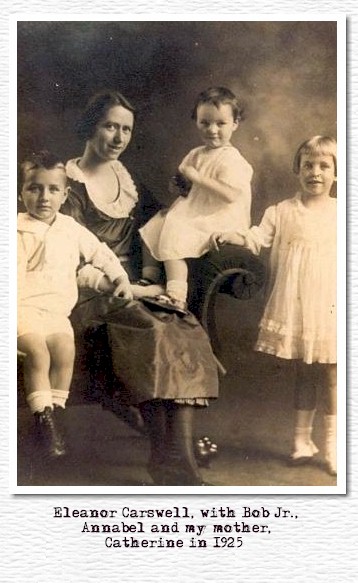 On
Corregidor, the family took up residence on Topside at lower quarters
#23, right behind the famous flag pole. Their furniture didn’t, much to the unhappiness of my grandfather. Harry Julian was
assigned to the Guard Battalion, and they lived on Middleside. The Julians left Corregidor in 1936 with a new addition, their son Bob. Bob
was born at Sternberg General Hospital in Manila. There was a flu
epidemic on Corregidor at the time, and most of Corregidor’s hospital
staff were sick.
On
Corregidor, the family took up residence on Topside at lower quarters
#23, right behind the famous flag pole. Their furniture didn’t, much to the unhappiness of my grandfather. Harry Julian was
assigned to the Guard Battalion, and they lived on Middleside. The Julians left Corregidor in 1936 with a new addition, their son Bob. Bob
was born at Sternberg General Hospital in Manila. There was a flu
epidemic on Corregidor at the time, and most of Corregidor’s hospital
staff were sick. 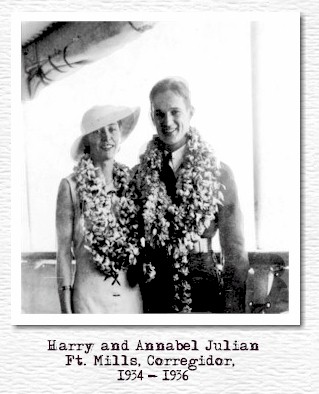
 My
dad was the son of poor Swedish immigrants to the Pittsburgh area. He
ran away from home and joined the Army, one of the few places where jobs
were easily available during America’s Great Depression.
He
was in the 1st Calvary in an armored car unit stationed in Texas.
He soon realized that it was better to be an officer than an
enlisted man. So he studied hard, took the examination for the US
Military Academy1
(USMA, West Point), and
scored first on the exam that year. He graduated in 1935 from West Point
with an excellent scholastic and athletic record.
His
first two posts were in the Coast Artillery at Ft. Story and Ft. Monroe
in Virginia. Posted to Corregidor, he was first in the 60th CA (AA) and
had his guns on the plain in front of the "Y." Someone within
the War Department must have had a wry sense of humour as his next
assignment on Corregidor was as commander of the US Army Mineplanter (USAMP) Harrison,
within the 59th CA. This was commissioned in 1919 and
was named for General George Harrison, the first American governor of
the Philippines. The mineplanter maintained the minefield in the North
Channel of Manila Bay (the Navy maintained the South Channel minefields,
from their base in Cavite), adding to the defenses of the much
better-known "big guns" of Corregidor. (More on the mineplanter and the minefields will come later.) It docked at the North
Dock, where the water taxis dock today.
My
dad was the son of poor Swedish immigrants to the Pittsburgh area. He
ran away from home and joined the Army, one of the few places where jobs
were easily available during America’s Great Depression.
He
was in the 1st Calvary in an armored car unit stationed in Texas.
He soon realized that it was better to be an officer than an
enlisted man. So he studied hard, took the examination for the US
Military Academy1
(USMA, West Point), and
scored first on the exam that year. He graduated in 1935 from West Point
with an excellent scholastic and athletic record.
His
first two posts were in the Coast Artillery at Ft. Story and Ft. Monroe
in Virginia. Posted to Corregidor, he was first in the 60th CA (AA) and
had his guns on the plain in front of the "Y." Someone within
the War Department must have had a wry sense of humour as his next
assignment on Corregidor was as commander of the US Army Mineplanter (USAMP) Harrison,
within the 59th CA. This was commissioned in 1919 and
was named for General George Harrison, the first American governor of
the Philippines. The mineplanter maintained the minefield in the North
Channel of Manila Bay (the Navy maintained the South Channel minefields,
from their base in Cavite), adding to the defenses of the much
better-known "big guns" of Corregidor. (More on the mineplanter and the minefields will come later.) It docked at the North
Dock, where the water taxis dock today.
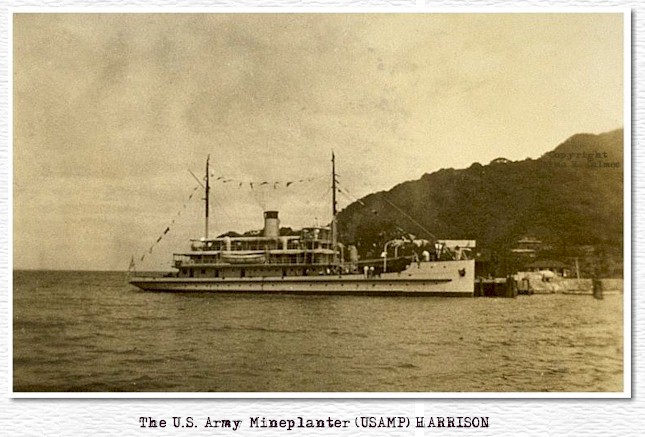
 Although my mother had identified my
father-to-be as a possible romantic interest at the beginning of the trip, something
interfered. A friend had given her a copy of the newly released novel, Gone with the
Wind. My father had to wait until she finished the novel!
Although my mother had identified my
father-to-be as a possible romantic interest at the beginning of the trip, something
interfered. A friend had given her a copy of the newly released novel, Gone with the
Wind. My father had to wait until she finished the novel!
When she was ready, she sent her brother Bruce, a precocious 10 year-old, to go talk with my father-to-be. Then my mother came up to say Bruce had to go do his lessons. One thing soon led to another and they began dating.
Several of my dad’s West Point classmates and their families were also on board, and my mother and father-to-be’s social activity centered on this group. The group was all older than my mother, who had been very protected socially, and she had to learn a lot quickly to keep up with them. Tropical sunsets and an easy life-style made it easy to develop a relationship. She and my father also found a number of dark places on the ship to retreat by themselves for some heavy "necking," but his white summer uniform made him easy to spot.

On arriving in Manila, they went to the Army-Navy Club, the social center for Army and Navy personnel in the Philippines then. Later they boarded the Corregidor-based "Miley," a little passenger boat with a Filipino crew, for the trip to Corregidor, another two hours away.

The relationship continued after they arrived on Corregidor. My mother settled in with her parents and brother in officers’ quarters on the Stockade Level (pictured above), and my father lived at the Batchelor Officers’ Quarters on Topside, a two-story concrete building next to Headquarters,(pictured below).
 |
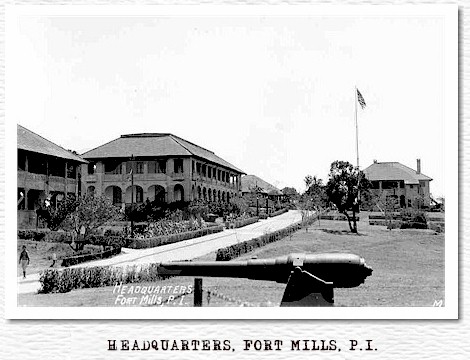 |
 |
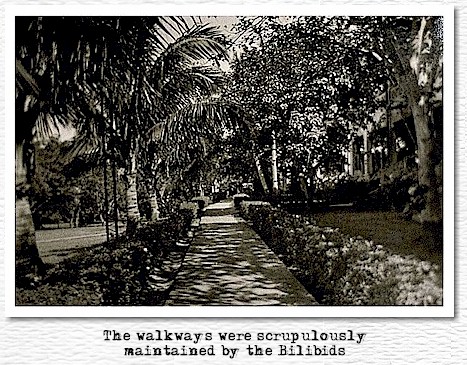 |
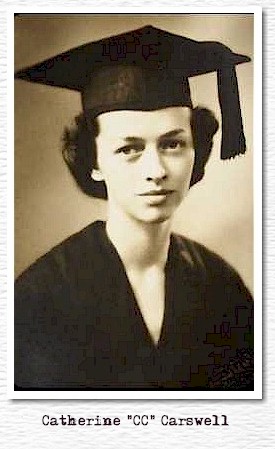 Corregidor’s
busy social schedule led to their being together nearly daily, until my
grandfather decided my mother should finish college. (She had left
Westhampton College in her junior year, when the orders for Corregidor
came). The only place for her to go was the University of the
Philippines in Manila, so she moved to Manila to finish school.
Ex-Philippine President Ferdinand Marcos was a classmate.
Corregidor’s
busy social schedule led to their being together nearly daily, until my
grandfather decided my mother should finish college. (She had left
Westhampton College in her junior year, when the orders for Corregidor
came). The only place for her to go was the University of the
Philippines in Manila, so she moved to Manila to finish school.
Ex-Philippine President Ferdinand Marcos was a classmate.
Fortunately, the mineplanter — with my dad in command — was often in Manila, and their relationship could continue.
Meanwhile, my grandparents also moved to Manila, when he became assistant to Golden W. Bell, the legal advisor to the High Commissioner.
Unlike her sister Annabel, my mother had promised my grandfather she would finish college before marrying. As her graduation approached, their engagement could finally be announced. My Dad gave her an engagement ring, a West Point "miniature" of his big ring. This is a West Point tradition for engagements.
 May
3, 1939, she and my father were married in the post chapel, on the
second floor of the Headquarters building on Topside. Three hundred
guests attended, probably most of Corregidor’s officers and their
families. A special boat also brought wedding guests from Manila over to
Corregidor for the 4 PM event. The exit under the traditional arch of
steel, was formed by the crossed sabers of the ushers.
Those who know Corregidor have to wonder how hot and sweaty everyone
must have been at that time of day, at that time of year, while dressed
up for a wedding. A reception followed at the Officers’ Club, the
Corregidor Club.
May
3, 1939, she and my father were married in the post chapel, on the
second floor of the Headquarters building on Topside. Three hundred
guests attended, probably most of Corregidor’s officers and their
families. A special boat also brought wedding guests from Manila over to
Corregidor for the 4 PM event. The exit under the traditional arch of
steel, was formed by the crossed sabers of the ushers.
Those who know Corregidor have to wonder how hot and sweaty everyone
must have been at that time of day, at that time of year, while dressed
up for a wedding. A reception followed at the Officers’ Club, the
Corregidor Club.
My mother had a lovely white net-satin wedding dress made for her in Manila. She got extra attention from the designer, no doubt because of her father’s position in Manila. The designer even came over to Corregidor to dress her for the wedding and to be sure the dress was arranged perfectly through all the events.

As she entered the chapel, rain was falling, and some got on her veil. Many think this is a sign of sadness ahead. My mother didn’t believe in that superstition then, but it did come true only a few years later. Their wedding night was at her parents’ apartment in Manila; her parents stayed on Corregidor that night.
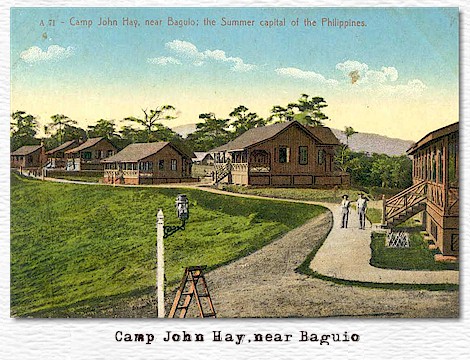
Their honeymoon was at the Army’s Camp John Hay in Baguio, where most Americans in the Philippines and a lot of well-to-do Filipinos went in the summer. Baguio, at 5,000 ft elevation, is much cooler than the rest of the Philippines in the summer. Each American Army officer could stay there one month a year.) They drove there in my dad’s little red roadster, which he had brought from Corregidor on the mineplanter. They stayed in Camp Hay's rustic cabins , ate in the dining hall, walked and explored the local area and its people.
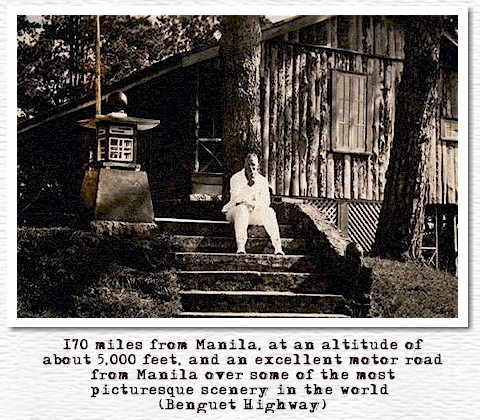 |
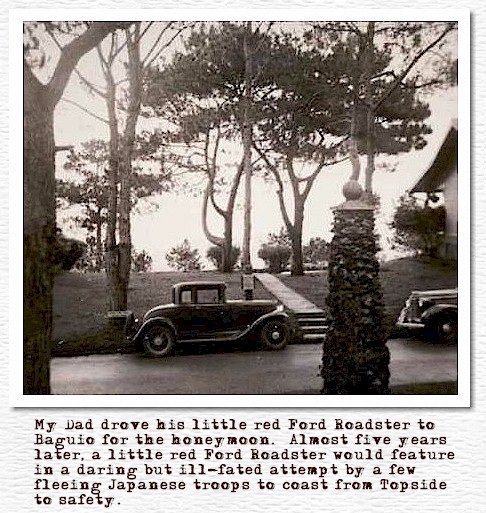 |
 On
their return to Corregidor, they moved into the lower level of the end
unit (closest to the hospital building) in Middleside officers’
quarters, Quarters 102. I arrived on Corregidor 9 months later, in
the delivery room at the Ft. Mills’ Hospital. My father was over in
Manila at the time (he often had to take the mineplanter to Manila), and
the maid had to take my mother to the hospital. I came before my dad
could return to Corregidor.
On
their return to Corregidor, they moved into the lower level of the end
unit (closest to the hospital building) in Middleside officers’
quarters, Quarters 102. I arrived on Corregidor 9 months later, in
the delivery room at the Ft. Mills’ Hospital. My father was over in
Manila at the time (he often had to take the mineplanter to Manila), and
the maid had to take my mother to the hospital. I came before my dad
could return to Corregidor.
Aunt Annabel and Uncle Harry Julian, accompanied now by two children, also arrived on Corregidor again, 10 days after I came. This was their second tour of duty on Corregidor, and they lived just down the row of quarters from my parents. Uncle Harry Julian was now a 1st Lt and commanded D Battery of the 59th . Because my mom and aunt were both married to men named Harry, their conversations included frequent references to "your Harry" and "my Harry."
With a new baby, her sister nearby and her parents in Manila, and supported by servants and with a busy social life as an officer’s wife, things seemed ideal for my mother and her family. Yet, something fearful was entering their idyllic life.
One day in 1941, soon after she arrived on Corregidor the second time, my aunt decided to buy some bamboo furniture, but my grandfather sternly warned her, "Don’t waste your money. You may have to leave suddenly—alone."
It was clear to senior Army officers that war was coming, and coming soon.
![]()
|
ABOUT THE AUTHOR
Who said "You can never go home"?
|
FOOTNOTE:
1. Appointment to the USMA at West Point is normally by Congressional appointment. However, 4 places per year (at that time) were allocated to regular Army men who were selected by rankings in the written examination. <Back>